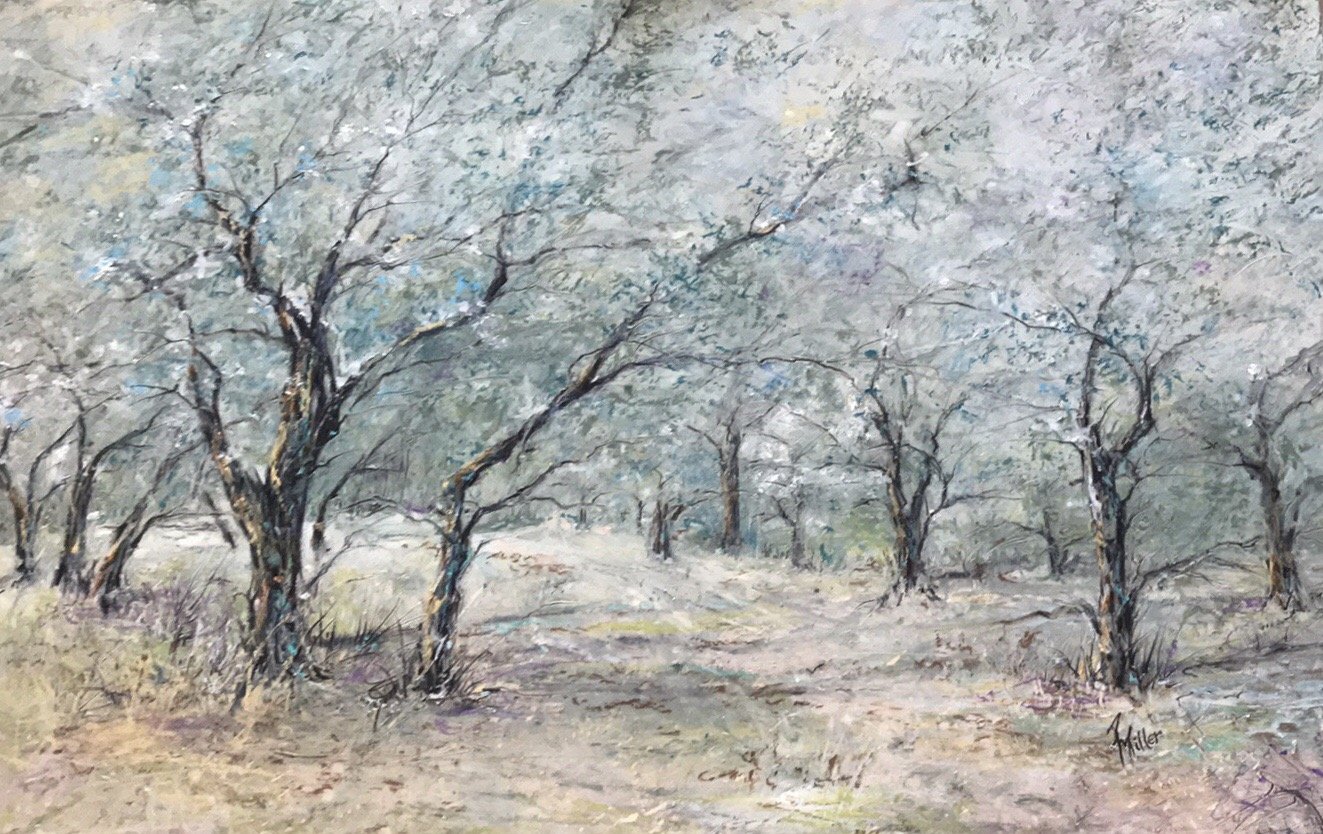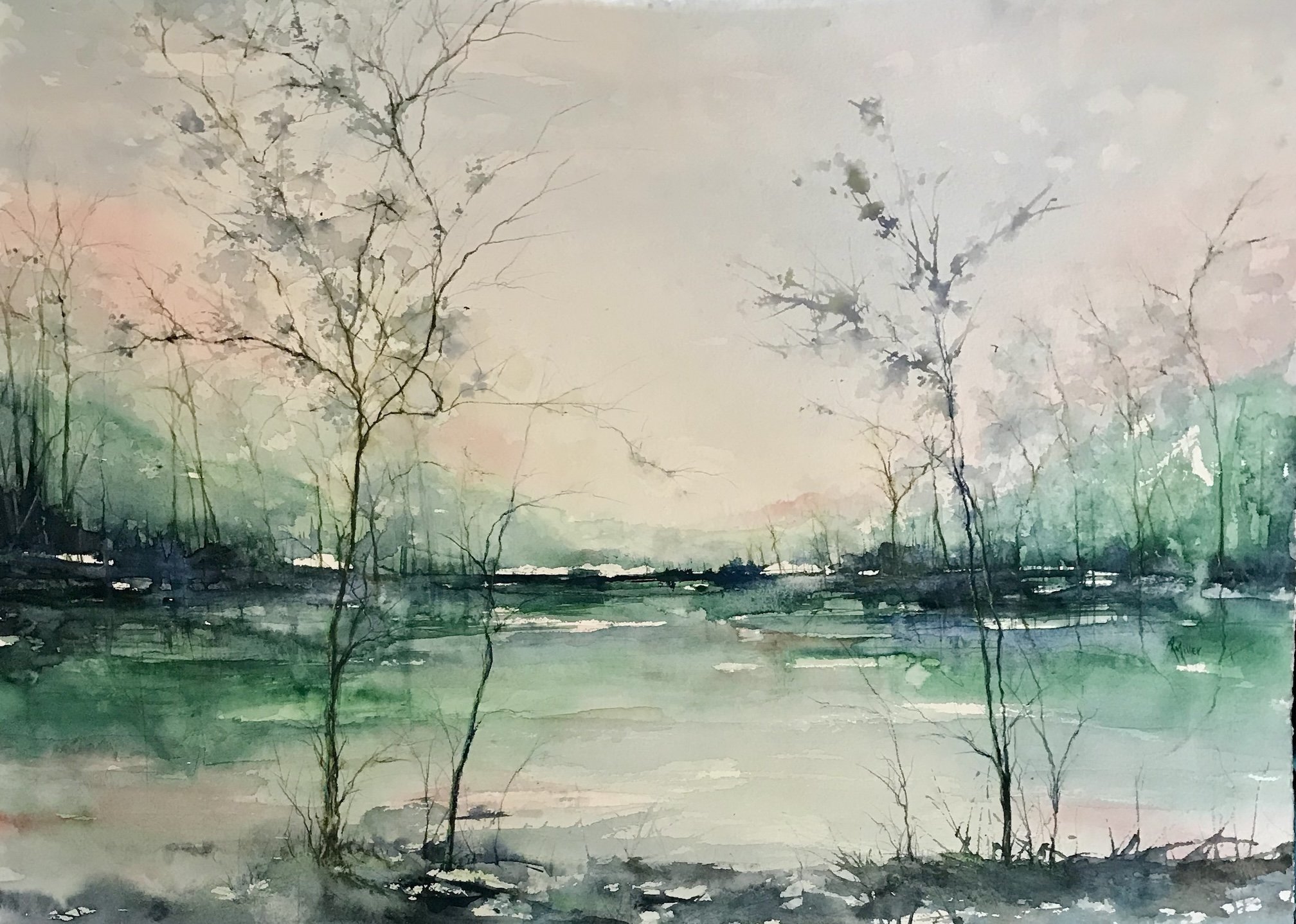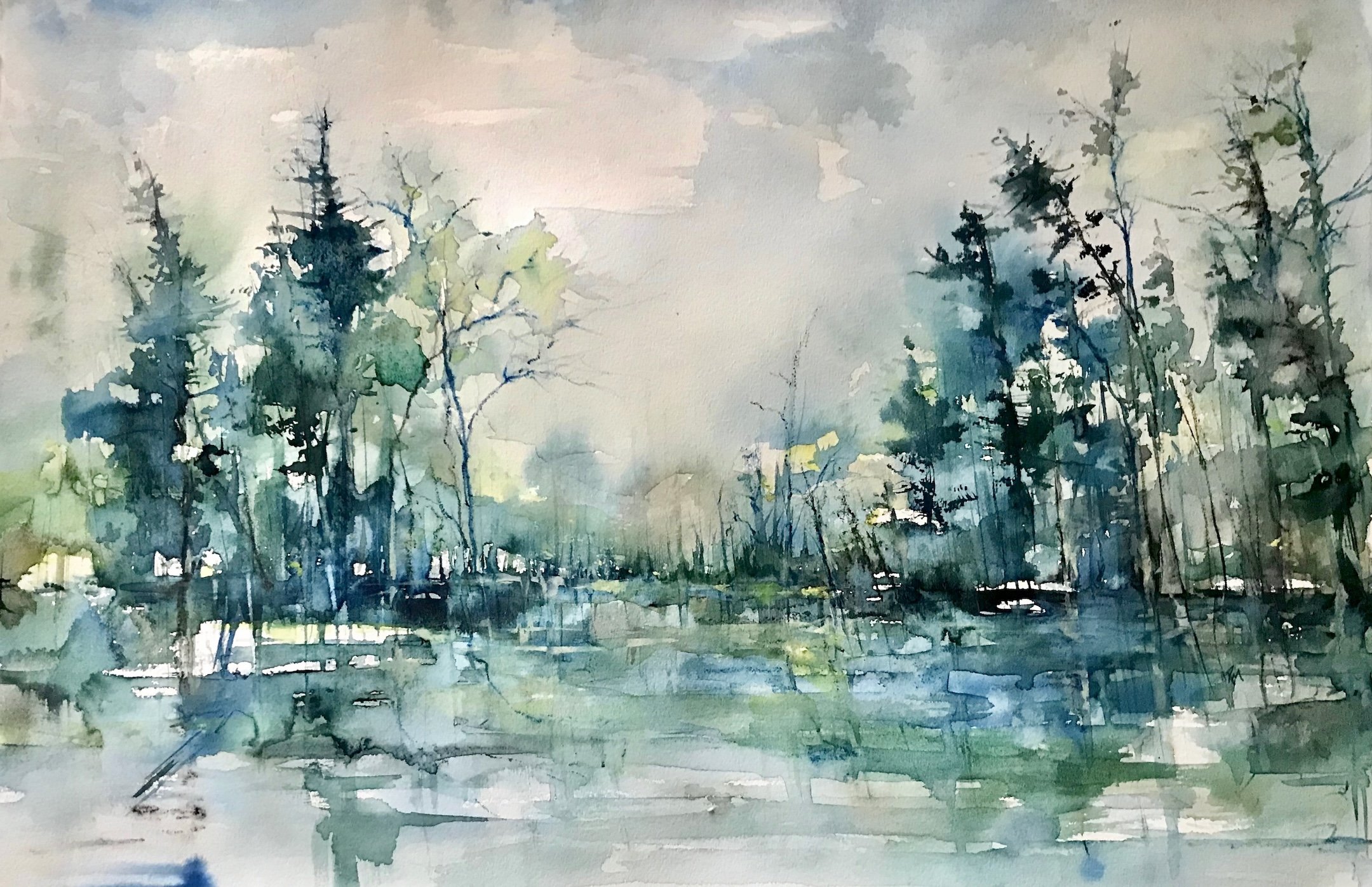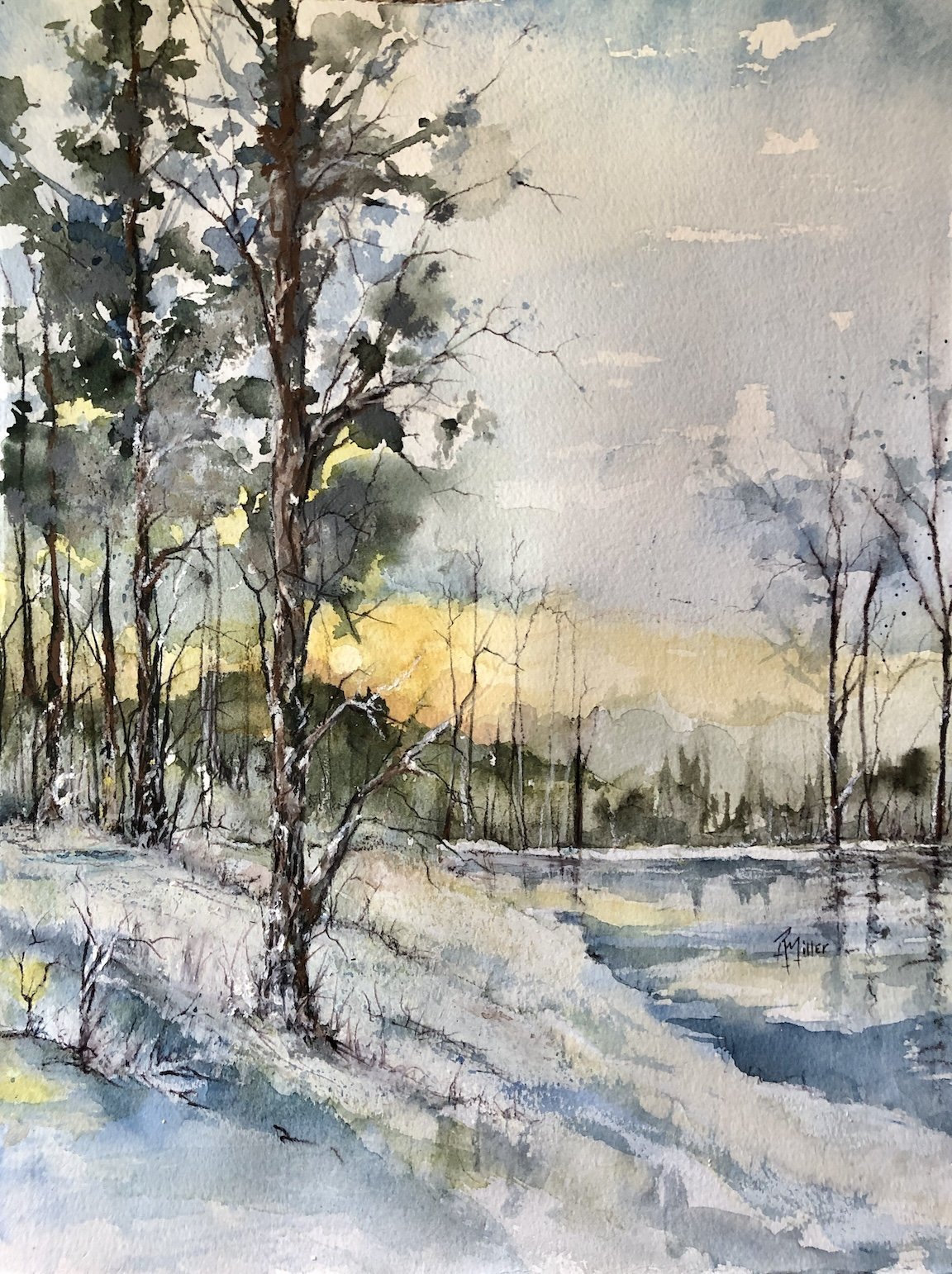Interview with artist Robin Miller-Bookhout
Robin Miller-Bookhout is a Hot Springs artist who finds the flow and unpredictability of watercolor matches her own spontaneity and free spirit. Her florals and landscapes are delicate and strong at the same time, born from her understanding of composition and technique. Robin’s paintings have been exhibited throughout the South and have earned many juried awards. More of her work can be found at her website.
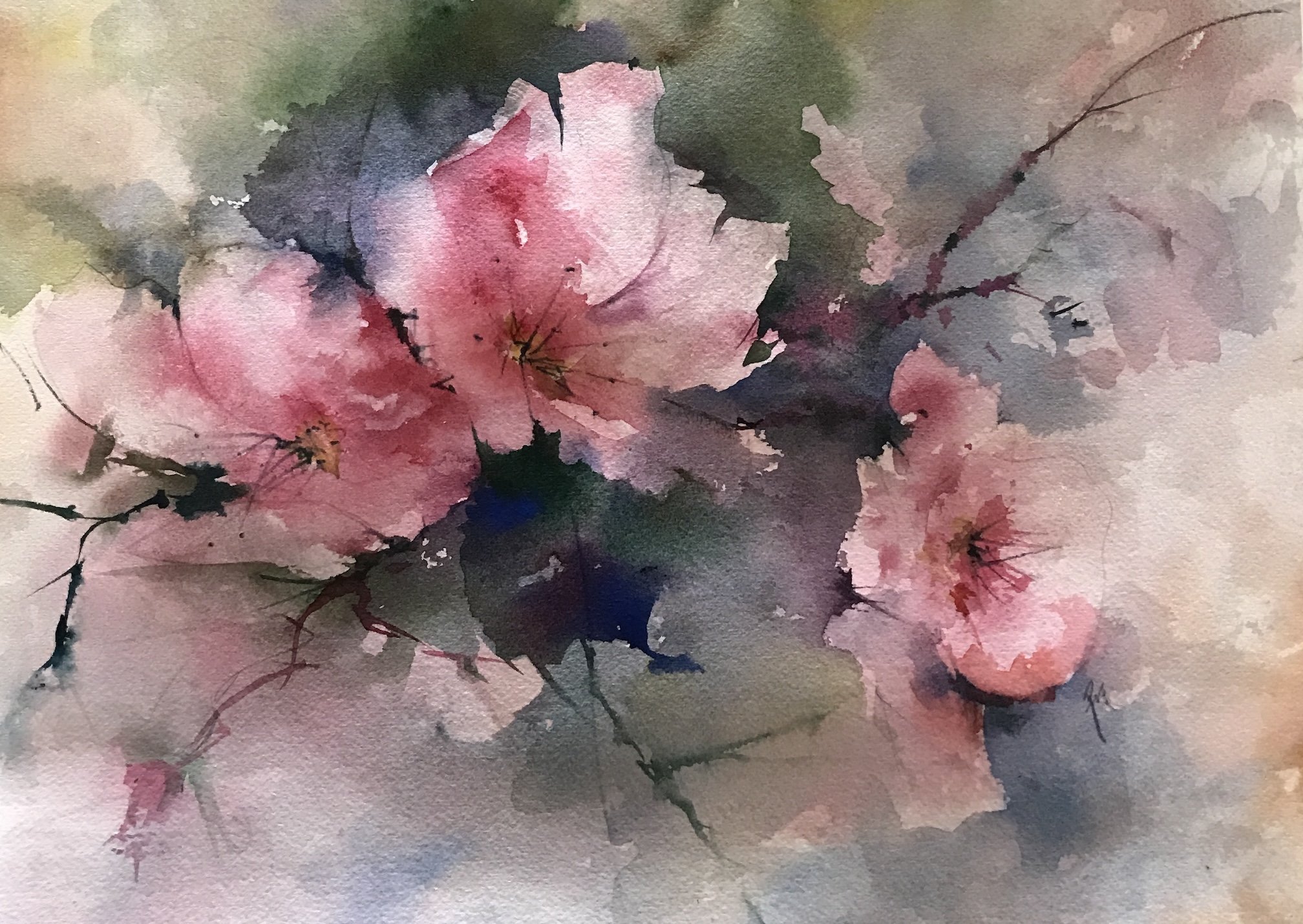
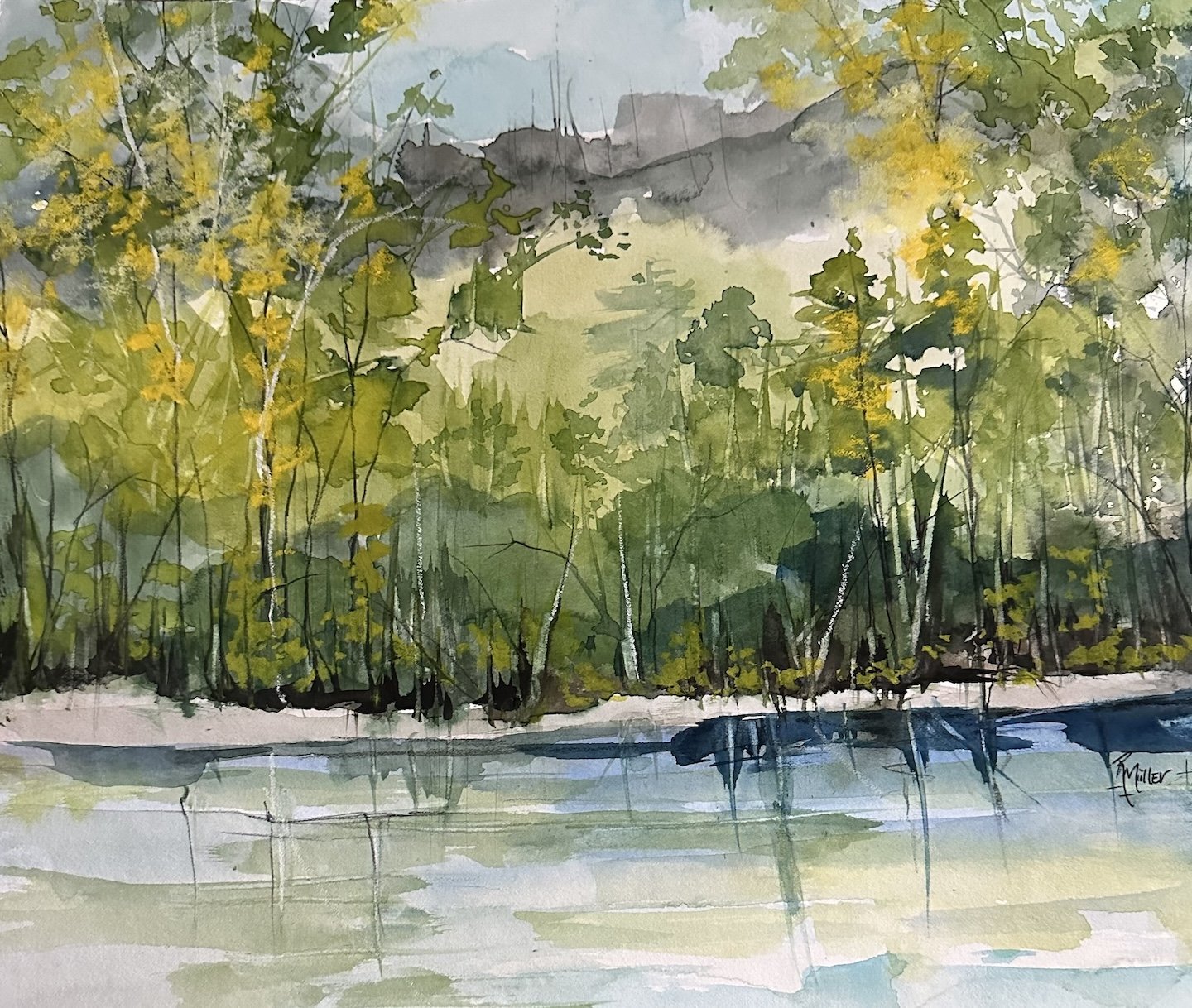

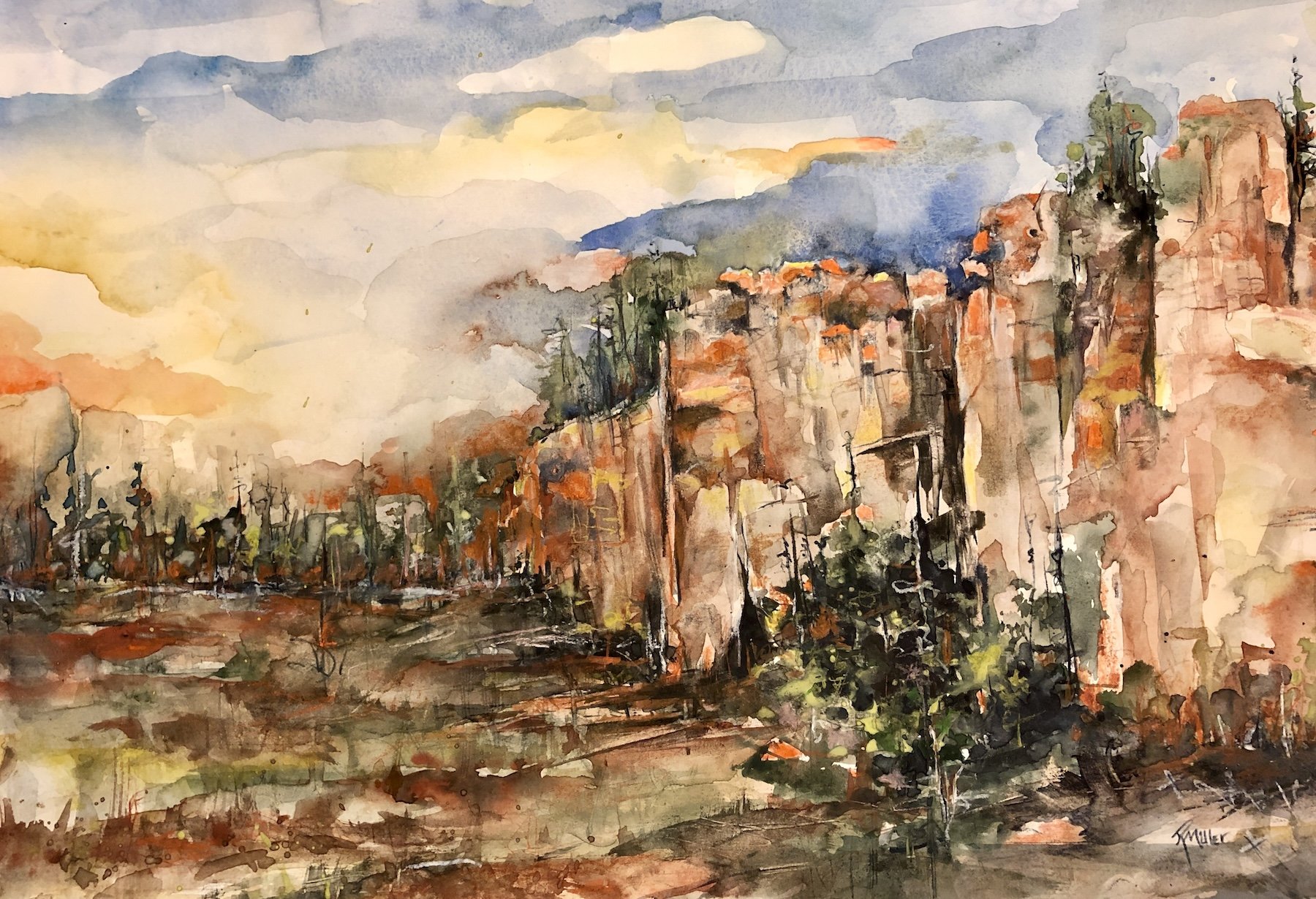
AAS: Robin, I know you are originally from Arkansas. Where did you grow up?
RMB: Thank you, Phil, and AAS for this interview and allowing me to tell part of my story. I grew up in Malvern, Arkansas. It was a wonderful little town under 10,000 folks, where it is true, everyone knows your name. I had a great childhood and lived in a very supportive community.
After high school, I entered college and the first question asked to me by the Registrar was, what are you interested in? Of course, my answer was “I don’t know.” The Registrar kept asking questions and I finally came to a eureka moment. He said “ART!” and I thought ok, that’s doable since I loved art. So, for years, I took more art courses/classes and dabbled with the other academic disciplines. Almost 7 years and over 180 curriculum hours later, my parents said, “Get your degree Robin!” So, I graduated in 1977 from Arkansas Tech University in Russellville with a BSE in Art Education K-12. My Master of Arts in Teaching from Harding University came many years later in 2004.
I figured I could either be a “starving artist” (which didn’t really appeal to me) or an art teacher in public school and encourage youth as I was encouraged. I chose to be an “Art Teacher Lady” and my first job was creating an art department and a K-12 art program at Heber Springs School District. Later, I moved to Little Rock and taught at Horace Mann Junior High and continued there where I became the Chairperson for the Visual Arts Department for Horace Mann Arts and Science Magnet Middle School. Thirty plus years later I retired and as I like to say, I finally graduated middle school.
During those early teaching years, I enjoyed art classes at the Arkansas Art Center where I studied watercolor with Cathey Tharp Altvater, one of the founders of the Mid-Southern Watercolorists. I was on the road to finding my future love for watercolors.
AAS: Did you have any artist role models growing up?
RMB: I am so fortunate to have been influenced by many excellent artists, colleagues, and mentors in my art and my life. My first and foremost mentor is God, who I always say paints my paintings for me. He uses my hands and heart to create artworks and deserves the credit for all of my endeavors.
As a young child growing up, the performing arts didn’t quite suit me. I realized quickly that I was not meant to be a tap dancer, nor a pianist. My parents wanted me to experience and enjoy the aesthetics, so they promptly found my first mentors in the visual arts from our local community artists. Ms. Prickett, my 3rd grade teacher provided after school drawing and painting classes in the neighborhood since there was not a formal art curriculum in the small school district. She did teach us cursive writing in school which is really a form of calligraphy -the art of beautiful handwriting. As long as I can remember, I have had a passion for creating art. I loved everything art. I loved drawing house plans, creating fashion drawings, staring at the moving clouds in the sky that resembled animals and objects that my “left brain” could identify and even weaving necklaces made out of fields of clover.
Another special childhood mentor I hold with endearment is Ms. Massey, another elementary teacher. After years of lessons with Ms. Prickett , my mother knew Ms. Massey and her love for art, so I soon found myself at her easel taking private lessons. Later my mother was studying china painting from Ms. Claudia Mason, so before I knew it, I was painting on porcelain too. I feel painting on porcelain encouraged my love for watercolors since the application, technique and process have so many similarities to watercolor. These early mentors enabled me to find my joie de vivre in the arts and I feel their guidance and expertise is evident in my art and life today. I am blessed and thankful to have had them in my life.
“I have always thought of watercolor as my first true love because of its spontaneity and free spirit. When I paint in watercolor, my mind gets in a state of flow much like a meditation. Watercolor painting is simply good for the soul.”
AAS: I first saw your work at the recent Mid-Southern Watercolorists Exhibition at the Laman Library in North Little Rock. Why do you feel it is important for you as an artist to be an active participant in the community of artists?
Aspens and Birch, 18” x 12”, watercolor
RMB: I am delighted our paths converged Phil and you saw Aspens and Birch - In My Soul II at the Laman Library. I was thrilled and humbled to have been juried into this exhibition and to hang with such wonderful watercolor artists. This piece did not win any individual awards at MSW but was selected January 2024 by FASO (Fine Art Studio Online) for their BoldBrush Painting Competition. I have always enjoyed MSW as a member since I joined around 1977, but I have not been as active as I would like to be. As a member for nearly four decades, this was my first time to enter my work in an MSW juried show until this 54th exhibition of 2024. I look forward to entering more work in the future because it is important to be a part of a community of artists and be able to share our expertise and love of the arts.
AAS: I want to ask you first about your wonderful landscapes. Simplicity is one of my favorites because its composition and color give it a mysterious quality and a Japanese or Chinese feel. Do you derive much inspiration from Japanese and Chinese watercolor and ink paintings?
Simplicity, 20” x 14”, watercolor
RMB: This is one of my favorites pieces too because it has the simplicity of Japanese drawing (sumi-e) and Chinese brush painting with the quick, strong, effortless brush strokes. Many have told me that they see an eastern art influence in my watercolor work. I take that as a wonderful compliment since these artforms rely on the premise that negative space is as important as the positive space while not cluttering the plane through keeping it simple. That’s what makes Simplicity, mystical and maybe a bit magical while the viewer taps into their own imagination to complete the visual dialog of the piece. The art element of value is important in sumi-e and I was working to create the importance of value throughout my piece with a limited palette. I continue to enjoy studying these Eastern art-forms. They have so many similarities to the media of watercolor and water-soluble inks, such as the inherent nature of the fluidity of the medium, and the techniques of working from light to dark, painting the background then the foreground, and layering paint while creating depth and transparency.
Richard Stephens is a masterful watercolorist and I learned in his “Lighten Up-Loosen Up” workshop to get out of watercolor’s way. I took this to heart, as I have a tendency to paint and overwork watercolors, as do many artists that enjoy this medium. I did not want Simplicity to be crowded, nor overworked. I believe the best way to solve this artistic problem is through continuous practice, practice and more practice. I am proud to say after years and years of practice, I am now a watercolorist and will continue to be a lifelong student of watercolor.
AAS: Blue Willow is a wonderful painting characteristic, I think, of your use of a limited color palette to enhance the emotional feel of the painting. Tell me about that painting and your use of color in a landscape.
Blue Willow, 16” x 20”, watercolor
RMB: In this monochromatic watercolor, the different values of blue create a peaceful and serene feeling for the viewer. This piece was inspired by Guy Robicheaux, who is a dear artist friend, who became one of my forever mentors that I met through the Slidell Art League in Louisiana. At that time, I was living on the Northshore of New Orleans fulfilling a scholarship with the Arkansas Committee of the National Museum of Women in the Arts I received to compare and contrast the flora/fauna, and cultures of our state of Arkansas with our sister state of Louisiana. Years later after many preliminary sketches and studies, Blue Willow was officially conceived from the “pigments of my imagination” and the many photographs I took while I was living on the Louisiana bayous.
Blue Willow has won several awards which I was so blessed and humbled to receive. One award was for “Outstanding Watercolor” for Faso’s BoldBrush Painting competition in June 2020.
AAS: Another example of your use of color is Christmas in July – Ode to My Father. What is the story behind it?
Christmas in July – Ode to My Father, 12” x 10”, watercolor
RMB: This painting has a very special place in my heart because my father was one of the greatest influencers in my life. He was always proud of my art and exhibited my labors and gifts of love throughout our home. After he passed, I had the opportunity to paint this piece with him in mind. He was born in July and was well-known for always greeting friends and strangers with a joyful smile and a verbal “Merry Christmas” throughout the year. With the memory of his joyful smile and my love of color, particularly alizarin crimson and greens (his favorite hues too), this painting came to be in time for an upcoming show entitled Lasting Impressions. I was honored and very humbled to have it receive the Best in Show by one of my favorite contemporary watercolorists, juror, Andy Evansen. This piece is hanging in Hot springs at the Market Place on Central Avenue.
AAS: Do you try to paint every day?
RMB: I try to make time every day to paint, but if I am not painting, I might be organizing my art studio, working on art correspondence, or thinking about the next painting. Not a day goes by that I don’t think about something involving art. Sometimes I just look around my world finding shadows and textures, color relationships, the spaces between shapes or forms, or looking at lines and perspective. It is important as an artist to continue to learn new things through workshops, read art critiques or even take a walk through a museum or attend a show opening in a gallery and share in artistic dialogue. Growth in my art discipline comes from all things related to art. The painting and practicing is part of that valued artistic process.
AAS: Are most of your landscapes painted on site or from photographs.
RMB: Most of my art landscapes are done in my studio and are inspired by places I have traveled and photographed. I have always loved travel and adventure – I have been told I am a gypsy at heart. My first plein air art adventure was a workshop in the south of France. I had never painted plein air using oil paints and I was a little reluctant, but was reassured by our workshop leader and mentor, Bob Snider, a wonderful teacher, oil painter, and watercolorist that this would be an adventure I would never forget.
To say it was a comedy of errors for me is an understatement. I do enjoy plein air painting and have an immense appreciation for plein air oil painters to say the least. After the workshop in Arles, I engaged a few friends to accompany me to the annual pilgrimage of international gypsies held each year at Sainte Marie dela Mer. An adventure I will talk about until the end of time. To say these adventures were life-changing is an understatement. After the international gypsy festival, I made my way north to Monet’s Garden in Giverny, painting his beautiful home and garden. With his spirit and inspiration, I was ready, set, go for another adventure. I returned to the US which took me to Tucson, Arizona where I had been juried to be a guest artist at Ted DeGrazia’s Mission in the Sun. I still am convinced Ted and my father would have been soul mates and I am blessed to have them as my guardian angels.
Then, guess what?…Covid hit!
So, I sold most of my possessions, my home, car and “stuff” and bought an RV and traveled throughout the US. During the next three years, I enjoyed my solo adventure recording my log of “Looking For America-Tales Of the Trails”, painting plein air wherever I parked my Lil Gitan (the little gypsy). As full-time RV’ers say, “Home is wherever you park it.” I did find America through the eyes of a wonderful community of traveling people who enjoyed visiting, watching, and talking art wherever I went. I met many artists along these 35,000 miles of travel in the US and Canada and found a great community of folks that I still communicate with and feel a close forever friendship. I still have my Lil Gitan RV and we frequently slip away, camp, paint and meet new friends.
AAS: In your floral paintings like Base de Fleurs you really exploit the unique qualities of watercolor. What is it about watercolor that you love?
Base de Fleurs, 14” x 11”, watercolor
RMB: I have always thought of watercolor as my first true love because of its spontaneity and free spirit. When I paint in watercolor, my mind gets in a state of flow much like a meditation. Watercolor painting is simply good for the soul. Base de Fleurs (Vase of Flowers) was inspired by my mother and her love for china painting. Whenever I paint flowers I feel very close to her as if I am channeling her.
I had the opportunity to study with a fantastic Brazilian watercolorist, Fabio Cembranelli. Fabio reinforced my love for watercolors because his paintings of flowers, landscapes and buildings were so loose and flowing. One day during the workshop, he came over to my easel for a chat and critique and said my work was so much like china painting, which he said was one of his mother’s favorite art forms. Of course, we immediately had a wonderful rapport and great visit about both of our mother’s love for china painting. After the workshop, Base de Fleurs was created and is in my private collection. But I did learn just last week that it was juried into the American Impressionist Society (AIS) 4th Annual Associate Member Online Show and I am thrilled.
AAS: Of course, you use other media and Ode to the Ladies on the White River, is one of my favorites because of its explosive color. Tell me about that painting and why you chose to use oil pastels.
RMB: This painting has become one of my favorite and familiar series. Ode To the Ladies On the White River was inspired by four of my dear “Out For Trout Friends” who frequent this beautiful river in Arkansas, fishing, laughing, and sharing yarns all the way. One of the ladies photographed this spot on the river in all the seasons and it became my muse.
I chose oil pastels over watercolor because the color from oil pastels can have so much color intensity and I wanted the piece to be strong. Also, I used oil pastels because of my love of the Woodward Brothers of New Orleans. Their contribution to the Southern artworld and their medium of choice and substrate, being oil pastels on cardboard, seemed the best choice over watercolor. It is easier to correct mistakes with oil pastels as opposed to watercolors and I could apply the oil pastels to create texture and use the alla prima technique to achieve this textural effect. All of my oil pastels are applied by hand, with no brushes or solvents.
Ode To the Ladies On the White River, 12” x 18”, oil pastel
AAS: You taught in public schools for so many years. Looking back, what did you enjoy most about that time.
RMB: My teaching career spanned over three decades where I wore many hats. As an art specialist/teacher, I dealt with many aspects of the educational process. My favorite part and what I enjoyed the most was the studio and classroom instruction. Working one on one with the kids and engaging them problem-solving in their art and life would be what I enjoyed the most about teaching. Working on a positive self-esteem was a daily task which we all felt was rewarding from both sides of the desk. We learned and enjoyed respect for one another and respect for the art of others while practicing a lot of kindness.
After developing the K-12 art program in Heber Springs, I interviewed for an art teacher vacancy with the Little Rock School District. The principal hired me on the spot, but asked if I could teach shop (aka Industrial Arts). I, being naive, said yes. He seemed so excited about filling an art and shop vacancy, which I found out later that I was the 3rd teacher hired in this position and they had all left the job within the year. I was delighted to work in the city doing what I loved to do which is teaching art to kids. Although I must admit it was challenging.
I want to mention here how I received the moniker “Art teacher lady”. This name was given respectfully to me by my first-year class of gentlemen from Granite Mountain. They said they paid attention because they weren’t sure what that little lady was going to do next. They all agreed I earned the title since I never walked off the job and I always respected and believed in them. The students were my greatest joy as a tenured teacher.
